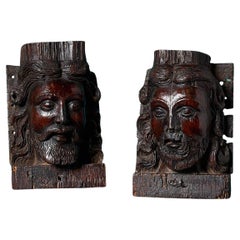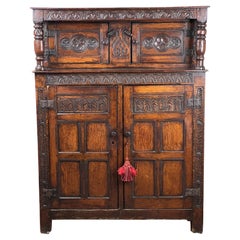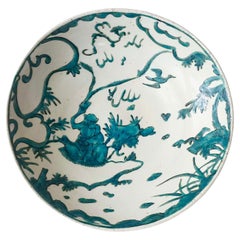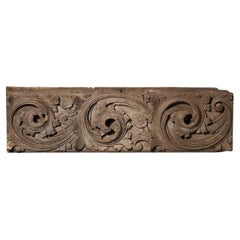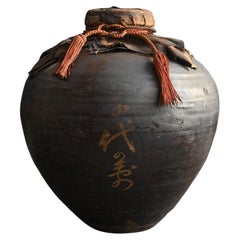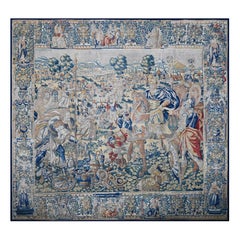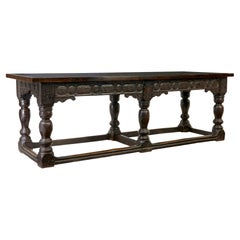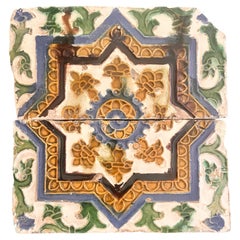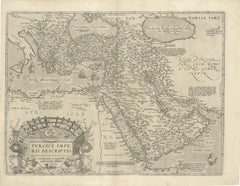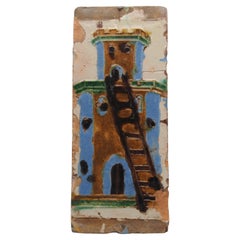16th Century Furniture
to
154
718
399
1,162
35
24
19
7
6
3
1
1
39,827
133,013
536,802
279,369
84,479
256,262
122,832
12,708
5,687
18,482
22,479
19,524
53,403
71,793
60,739
21,354
9,069
405
239
220
158
144
642
291
190
140
123
1,162
1,162
1,162
20
6
3
3
2
Period: 16th Century
Antique Chinese Pottery 【Luzon Jar】/Iron-glazed teapot/15th to 18th centuries
Located in Sammu-shi, Chiba
This is an antique ceramic jar, commonly known as a “Luzon Jar,” made sometime between the 15th and 18th centuries. It is believed to have been produced in southern China and then us...
Category
Chinese Other Antique 16th Century Furniture
Materials
Pottery
Roman Triumph - Fine Brussels Tapestry from 16th Century - 355lx300h - No. 1507
Located in Paris, FR
Manufacture Des Bruxelles
Epoque: 16th century
Style: Rome and Ancient Greece
Condition: Perfect condition
Material: Wool & Silk
Width: 355 cm
Height: 300 cm
Depth: 0.5 cm
Roman Tri...
Category
Belgian French Provincial Antique 16th Century Furniture
Materials
Wool, Silk
16th century and later Elizabethan solid oak refectory table
Located in Debenham, Suffolk
16th century and later Elizabethan solid oak refectory table circa 1590.
We are pleased to offer this beautiful table, with Elizabethan period bas...
Category
English Elizabethan Antique 16th Century Furniture
Materials
Oak
Spanish Azulejo Tiles 'Dos por Tabla' - Arista y Cuenca - Toledo 16th century
Located in DELFT, NL
Set of Spanish tiles of the 'dos por tabla/ type in the Arista y cuenca tile made in Toledo. This particular type was to adorn ceilings.
Tile decorated in renaissance with stylized ...
Category
Spanish Renaissance Antique 16th Century Furniture
Materials
Earthenware
16th-Century Map of the Ottoman Empire and Near East: Turcici Imperii Descriptio
Located in Langweer, NL
Title: Original 16th-Century Map of the Ottoman Empire and Near East: *Turcici Imperii Descriptio* by Ortelius, 1571
This rare copperplate engraving, Turcici Imperii Descriptio, i...
Category
Antique 16th Century Furniture
Materials
Paper
Heraldic Spanish Azulejo Tile - Arista y Cuenca - Sevilla, early 16th century
Located in DELFT, NL
Important heraldic Spanish tile of the 'azulejo por tabla para techo' type, in arista y cuenca technique, made in Sevilla in the early 16th century.
Depicting a two-section tower an...
Category
Spanish Renaissance Antique 16th Century Furniture
Materials
Earthenware
1584 Abraham Ortelius Map of Lower Burgundy, France
Located in Langweer, NL
1584 Abraham Ortelius Map of Lower Burgundy, France
Description of the Map:
This antique map by Abraham Ortelius, titled "Bvrgvndiae Inferioris Qvae Dvcatvs Nomine Censetur Des," w...
Category
Antique 16th Century Furniture
Materials
Paper
16th Century Spanish Moorish bronze mortar
Located in Delft, NL
16th Century Spanish Moorish bronze mortar
A small round bronze dark brown patinated shaped mortar, resting on a round base. The exterior decorated with vertical rib pattern from t...
Category
Antique 16th Century Furniture
Materials
Bronze
16th Century primitive full oak Spanish ship table with beautiful patina
Located in Meulebeke, BE
Spain / 16th century / table / oak, wrought iron / Rustic / Mid-century
A very early and rare oak table from the heritage of a Spanish ship. Hand crafted in full oak in the16th cen...
Category
Spanish Spanish Colonial Antique 16th Century Furniture
Materials
Wrought Iron
16th Century Map of Saudi Arabia, the Persian Gulf and Red Sea, ca. 1574
Located in Langweer, NL
Ptolemaic map of the Arabian Peninsula based on the 1548 map of Giacomo Gastaldi. It covers nearly all of the peninsula, but does not include the head of the Red Sea. The coastlines ...
Category
Antique 16th Century Furniture
Materials
Paper
Venetian Renaissance Jewelry Chest
Located in Greenwich, CT
Rare Venetian 16th century Italian traveling jewelry chest profusely decorated in Arabesque black and gilt decoration featuring rare specimen stone drawer fronts in a Palladian archi...
Category
Italian Antique 16th Century Furniture
Materials
Wood
16th Century Italian Renaissance Cabinet in walnut with rich carvings
Located in Meulebeke, BE
Italy / 16th Century / Cabinet / walnut / Renaissance / Antique
Rare 16th Century Italian Renaissance cabinet in walnut with hand carved decorations of 3 heads and floral patterns f...
Category
Italian Renaissance Antique 16th Century Furniture
Materials
Walnut
16th Century Italian Renaissance Carving of a Male Saint
Located in Stamford, CT
16th century Italian carved and polychromed figure of a male saint or prophet with a wonderful presence. Shown holding an open book in his right hand with flames at his feet, mid-16t...
Category
Italian Renaissance Antique 16th Century Furniture
Materials
Wood
Set of 20 large 16th century castle keys, France
Located in Meulebeke, BE
France / 16th century / set of 20 castle keys / metal / Antique / Rustic
Rare charming set of 20 Antique keys from the 16th century, France.
A beautiful ...
Category
French Rustic Antique 16th Century Furniture
Materials
Metal
Spanish Chest with Arcade design
Located in Saint-Ouen, FR
SPANISH CHEST WITH ARCADE DESIGN
ORIGIN: SPAIN
PERIOD: LATE 15TH – EARLY 16TH CENTURY
DIMENSIONS:
Height: 61 cm
Length: 135 cm
Depth: 48 cm
Chestnut wood
Good condition
This H...
Category
Spanish Gothic Antique 16th Century Furniture
Materials
Wood, Chestnut
Annamese Blue and White Ceramic Jarlet, Chu Dau kilns, Vietnam, circa 1500
Located in Point Richmond, CA
Annamese Blue and White Ceramic Jarlet, Chu Dau kiln, Vietnam, circa 1500. A shouldered globular form with narrow neck surrounded by under glaze cobalt blue d...
Category
Vietnamese Other Antique 16th Century Furniture
Materials
Ceramic
Swiss Chest richly carved, Riedmatten family, framed by two Holy conversations
Located in Saint-Ouen, FR
SWISS CHEST RICHLY CARVED WITH THE COAT OF ARMS OF THE RIEDMATTEN FAMILY FRAMED BY TWO HOLY CONVERSATIONS
ORIGIN : SWITZERLAND, VALAIS CANTON
PERIOD : END OF 16th CENTURY – EARLY 17...
Category
Swiss Renaissance Antique 16th Century Furniture
Materials
Wood, Walnut
Spanish Azulejo Tile Arista y Cuenca - Toledo 16th century
Located in DELFT, NL
Early Arista y cuenca tile made in Toledo. Tile decorated in renaissance with stylized flowers was probably made between 1550 and 1575.
Category
Spanish Renaissance Antique 16th Century Furniture
Materials
Earthenware
16th Century Ming Dynasty, Blue Design Set Of Three Plates On Stands, China
Located in New York, NY
16th century Chinese Ming Dynasty set of three hand painted plates on stands.
Plate sizes. 7 x. 14.5 7. x. 14. 7. x. 13.5
Stands measure. 5. x. 3. and. 4. x. 3
Category
Chinese Antique 16th Century Furniture
Materials
Ceramic
A Deruta Maiolica Dish Early 16th Century
Located in Firenze, IT
SHIPPING POLICY:
No additional costs will be added to this order.
Shipping costs will be totally covered by the seller (customs duties included).
The centre painted with archaic de...
Category
Italian Renaissance Antique 16th Century Furniture
Materials
Maiolica
A Rare Large Wucai Dragons and Phoenix Jar, Ming dynasty Longqing Emperor
Located in seoul, KR
The blue dragon and the red dragon are depicted in dynamic postures, each extending its claws to grasp a ruyi pearl (如意珠). The phoenix is adorned with flowing feathers and delicate c...
Category
Hong Kong Ming Antique 16th Century Furniture
Materials
Ceramic
Antique 16th century Spanish carved cabinet in oak
Located in Meulebeke, BE
Spain / 16th century / cabinet / oak / Rustic / Antique
A stunning Spanish antique highboard or cabinet in warm oak wood with two doors from the 16th century. The cabinet has its original keys and offers ample storage space behind the doors.
This hand carved antique oak cabinet...
Category
Spanish Rustic Antique 16th Century Furniture
Materials
Oak
Antique English Tudor Period Oak Panel c.1590
Located in Wormelow, Herefordshire
An antique English Tudor period oak panel dating to circa 1590, deeply handcarved with three large foliage scrolls and flowers. Over 430 years old, this oak wall panel has stood the ...
Category
English Tudor Antique 16th Century Furniture
Materials
Wood, Oak
Spanish Azulejo Tile Arista y Cuenca - Toledo 16th century
Located in DELFT, NL
Early Arista y cuenca tile fragment made in Toledo. Tile decorated in renaissance with stylized flowers was probably made between 1550 and 1575.
Losses and wear.
Category
Spanish Renaissance Antique 16th Century Furniture
Materials
Earthenware
A Rare Blue And White Octagonal Box And Cover, Ming Dynasty Wanli Six-Character
Located in seoul, KR
Numerous similar octagonal blue and white boxes with Wanli, Jiajing marks are housed in prestigious museum collections. An example in the Tokyo National Museum is featured in Illustr...
Category
Hong Kong Ming Antique 16th Century Furniture
Materials
Ceramic
Korean antique pottery black glaze vase/15th-16th century/small bottle
Located in Sammu-shi, Chiba
This is black glazed pottery made in Korea from around the 15th to 16th century.
This era in Korea is called the Joseon Dynasty.
This black glazed pottery was only produced for a sho...
Category
South Korean Other Antique 16th Century Furniture
Materials
Pottery
16th Century Spanish or Italian Baroque Wrought Iron Nails and Furniture Mounts
Located in Stamford, CT
Group of 16th century (or earlier, possibly Gothic) Spanish or Italian wrought iron furniture mounts. These hand-wrought bosses and nails show incredible workmanship. These would have been used to decorate - and to structurally hold together an early chest or casket. The four geometric bosses beautifully made, eight ounces each without the nail! The nails are works of art in themselves, with their heavy geometric heads.
Also two round bosses with the nail integral to the piece, one a mushroom form, the other like a parasol. And a single hand-wrought double sided nail. Great group of early iron.
Provenance: Frances Pratt, Writer, Artist, Collector. New York City.
Approximate sizes:
4 bosses 4.625 inches square 11.75 cm
Round bosses 3 inches diameter the larger 2.5 the smaller 7.6/ 6.35 cm
4.5 in high 11.4 cm
5 nails...
Category
Italian Baroque Antique 16th Century Furniture
Materials
Iron
Japanese antique pottery "Echizen ware" Large Jar/1500s/Rare large vase
Located in Sammu-shi, Chiba
It is "Echizen ware".
Echizen is a historic kiln located in Ishikawa Prefecture, Japan.
It is said to have originated around the 9th century.
There are 6 kilns with a long history in...
Category
Japanese Other Antique 16th Century Furniture
Materials
Pottery
Antique Elizabethan Tudor Oak Court Cupboard c. Late 16th Century
Located in Westfield, MA
This Antique Elizabethan Tudor Oak Court Cupboard, dating to the late 16th century, exemplifies the craftsmanship and aesthetic values of the Tudor period. Constructed from richly gr...
Category
English Tudor Antique 16th Century Furniture
Materials
Oak
Chinese Ming Dynasty Blue & White Porcelain Peacock (Swatow) Plate ca. 1600
Located in Nottingham, GB
This breathtaking Chinese Ming Dynasty blue and white porcelain plate, dating to circa 1600, is a stunning example of Swatow ware, renowned for its intricate designs and exceptional ...
Category
Antique 16th Century Furniture
Materials
Porcelain
Reclaimed French Rustic Style Limestone Architectural Element
Located in Beervelde, BE
An original antique burgundy hard stone bloc with a central lower part. Perfect to be used as a tabletop or for a Wabi Sabi spirit fireplace base and ca...
Category
French Antique 16th Century Furniture
Materials
Limestone
De re hortensi libellus, a 16th Century Children's Gardening Book
Located in Middletown, NY
Estienne, Charles
De re hortensi libellus (A small book on gardening); . . . vulgaria herborum, florum ac fruticum qui in hortis conseri solent nomina latinis vocibus efferre docens ...
Category
French Antique 16th Century Furniture
Materials
Gold Leaf
16th Century Spanish Terracotta Vase
Located in Miami, FL
16th Century Spanish Terracotta Vase
Hand made marks around the vase.
Category
Spanish Baroque Antique 16th Century Furniture
Materials
Terracotta
Antique 16th Century German (Augsburg) parcel-gilt Silver-Gold Chalice/Goblet
Located in Doha, QA
This is an absolutely exquisite rare Cooper-gilt ,silver-gold and three Sterling Silver angels Chalice originated from Augsburg (Germany ) in th...
Category
German Renaissance Antique 16th Century Furniture
Materials
Gold, Silver, Copper
Antique Japanese Koto Wakizashi Sword
Located in Dallas, TX
Japanese Koto Wakizashi Sword
Japan
Ca. 1400-1600s
Length: 24.25” Blade
Total Length: 27.25
Nagasa: 18.5”
Koto wakizashi, with wild midare (Soshu?) hamon, including wild boshi. Hada indeterminate, with Shakudo & gold dragon menuki, beehive design fuchi kashira...
Category
Japanese Japonisme Antique 16th Century Furniture
Materials
Steel
Korean antique black glaze pottery/Joseon period/15th-16th century/small vase
Located in Sammu-shi, Chiba
This is a small black-glazed jar made in Korea between the 15th and 16th centuries.
White porcelain is famous in Korea, but this was a type of porcelain that was only allowed to be u...
Category
South Korean Other Antique 16th Century Furniture
Materials
Pottery
French Medieval Painted Wooden Madonna
Located in Buisson, FR
Unique and extremely rare medieval wooden Madonna with traces of her original color
Original period piece, South of France, circa 1500 or older
Weathered, small losses and old repair...
Category
French Medieval Antique 16th Century Furniture
Materials
Wood
16th Century rustic cabinet in oak with ironwork, France
Located in Meulebeke, BE
France / 16th century / cabinet / oak, ironwork, metal / Rustic / Mid-century
A rare to find antique cabinet in solid oak with beautiful warm patina. Hand crafted in France in the 16th century. This tall cabinet has authentic ironwork decorations and wrought iron rivets and hardware. Behind the door, 4 spacious sturdy shelves.
This tall wooden cabinet...
Category
French Rustic Antique 16th Century Furniture
Materials
Wrought Iron
Renaissance Palace Wardrobe with Perspectival Views
Located in Saint-Ouen, FR
A rare carved walnut wardrobe opening with four door-leaves and two drawers in the lower part. The doors bear architectural views in low reliefs, fluted pilasters and Ionic capitals.
Upper Body
Two door-leaves with carved architectural perspectives open the wardrobe framed by three fluted pilasters with Ionic capitals.
Each door-leaf depict two semi-circular arcades whose cornice and base shows a central vanishing point. Likewise the pavement’s lines act for the artisan as a way to create depth. The vaulting instead leads us to think the vanishing point has to be situated where the handle is, between the two complementaries reliefs.
The elegant moulded belt hides an internal secret space, accessible through a moveable plank in the upper body.
Lower Body
Two door-leaves identical to those of the upper body framed by three fluted pilasters with Doric capitals. The base of the wardrobe opens with two large drawers.
The sides also bear panels depicting architectural perspectives. The external pilasters share their Ionic capital with the facade’s pilasters. Thus we can observe on the wardrobe’s sides the capital’s lateral parts with the elegant volute specific to the Ionic order.
This palace wardrobe is topped by an overlapping cornice standing on three consoles for the facade and two consoles on each sides. Placed right above the pilasters each console are adorned by fully expanded leaves.
During the 15th century a major interest for architecture and perspective studies arises and influences patrons tastes. The work of great theorists such as Leon Battista Alberti...
Category
Italian Renaissance Antique 16th Century Furniture
Materials
Walnut
Renaissance Cabinet from Burgundy or Lyon Region
Located in Saint-Ouen, FR
Renaissance cabinet from Burgundy Or Lyon Region
Origin : Burgundy Or Lyon, France
Period : Second Half 16th Century, C. 1580
Height : 209cm
Length : 184cm
Depth : 71cm
Good condition
Walnut wood, original keys and keyholes
Around the middle of the 16th century the conception and ornamentation of French furniture evolves. The start of major building projects, such as the castle of Fontainebleau, gives artists a new impulse. Inventive and rich formulas are developed there, before spreading to all of Europe thanks to engravings and printed leaflets. Furthermore, Italian artists working on such construction sites bring French artists and patrons a renewed taste for the Antique.
Regarding the art of furnitures, the most complex scenes and figures are drawn from illustrated books, ornament and emblem compendiums and engraving compilations. Rather than copying those images the artisans feed their inspiration and decline the motifs in numerous variations.
The ornamental grammar marks a return to the Antique : palm leaf, acanthus, egg-and-dart, greek, scroll, fluted pilaster… It is in Primaticcio’s and Il Rosso’s stuccos made around 1540-1550 that we have to look for the origin of leather cut-outs, masks, chimaeras, harpies, sheathed figures, fruit and flower garlands that soon enrich every pieces of French furniture.
The structure of the pieces of furniture also evolve thanks to the re discovery of Antique architectures, rigorously used as a model.
This cabinet presents an imposing structure and a rich and original decor exemplifying the production of the late 16th century, infused with Italian, Antique and Fontainebleau influences.
It stands on a moulded base ornate with palm leaves. It opens with four door-leaves and two drawers in the belt. Six whimsical terms divide the facade.
The lower body is horizontally divided by three sheathed female terms. The two standing on the lateral posts are topped with fruits while the body is covered by acanthus leaves carved with precision, belted at the waist. The term standing on the central door-jamb is crowned with laurel leaves and is draped in the Antique fashion. A wincing mask hides the key hole.
The two door-leaves are centred by a beautiful mask carved in a strong relief. They wear stylised feathered headdress and are set on draperies. Straps, leather scrolls, acanthus leaves and a shell are spread around the masks. The recessed panels are secured in frames ornate with acanthus leaves.
The belt is flanked by two large mouldings enriched with variations of acanthus leaves. The drawers are carved with choux bourguignons and palm leaf motifs minutely executed. The consoles between each drawer bear tormented wincing masks, showing horns as if they were fauns or imps.
The upper body is framed by two male terms characterised by a strong and nervous musculature, their manhood hidden by drapes secured thanks to a winged lion head. The term on the left appears to be younger and is wincing while the one on the right has a beard. The central female term brings contrast with her youth and sensuality. As it is the case on the lower body, the key hole is hidden behind the mouth of a faun’s mask placed on the drapes barely covering the intimacy of the caryatid.
The panels of the upper body present an idealised architecture comprising pilasters and sinuous broken pediments. The pilasters are flanked by two satyrs with goat legs. In the centre appears an important lion mask.
The terms of the upper body support the cornice. The entablature carries palm leaves and roses alternating as well as an egg-and-dart frieze. The cornice is adorned with acanthus motifs.
On the sides, the carving is executed flat. A central rose is surrounded by scrolls, flowers and choux bourguignons.
We can admire the variety of the elements employed. The artist vary with great genius many different ornamental motifs : palm leaf, egg-and-dart, laurel leaf, roses, scrolls … But the artist went even further as each profile and each face is individualised and presents different features. You can take a look at the faces of the satyrs flanking the upper body’s panels. The talent of the artist is undeniable.
It makes no doubt the patron who commissioned this cabinet was an aesthete looking for the greatest quality.
The artist who authored this cabinet had a great mastery of composition both in the general design and in the individual panels. They probably drew inspiration from engravings and drawings made especially for the making of this piece of furniture or not. They seem to be familiar with the style of Jacques Androuet du Cerceau. Indeed, we can find in Du Cerceau’s engravings the same juxtapositions of leather cut-outs, masks and fruits. The terms and caryatids used on the facade could very well be inspired by his work as well. The cabinet-maker was also undoubtedly observant of Hugues Sambin, the most famous cabinet-maker and sculptor in the Burgundy of the time. Like Du Cerceau, Sambin left an important ensemble of models particularly useful for the design of cabinets. His publication De l’Oeuvre de la diversité des termes dont on use en architecture (1572) was an essential book for every artisan.
All the motifs testify of the artisan’s high knowledge of forms as well as the precision of their tools : super imposition of ornamental elements, foliages, architectural cut-outs, flat and high reliefs alternating, palm leaves inscribed in circular spaces, wincing faces. It is also a testimony of the artisan’s familiarity with Italian and Fontainebleau productions.
Because of the proficiency of the cabinet-maker in so many different models, this cabinet truly is a master-piece authored by the hand of an authentic master.
The generous carvings executed with great rigour and virtuosity evoke an origin close to Burgundy and Lyon workshops. This cabinet was made by a master of the region during the Second French Renaissance.
Literature
BOCCADOR Jacqueline, Le mobilier français du Moyen-Âge à la Renaissance, Édition d’art Morelle Mayot, 1996
BOS Agnès (dir.), Mobilier du Moyen âge et de la Renaissance, La collection du musée du Louvre, Louvre éditions...
Category
Renaissance Antique 16th Century Furniture
Materials
Walnut
Wood Low-Relief Depicting a Werewolf and Saint George
Located in Saint-Ouen, FR
Exceptional polychrome wood low-relief depicting a werewolf and saint george after a woodcut by lucas cranach (“DER WERWOLF” 1512)
Provenance :
collection Brimo de Laroussihle
colle...
Category
German Renaissance Antique 16th Century Furniture
Materials
Wood
16th Century Venetian Silk Velvet Fragment
Located in Canterbury, GB
A large fragment of Venetian Silk Velvet
Dating from late 16th Century
One silk selvage edge present
Study / document piece.
Historic time worn appeal.
Please study photographs ...
Category
Italian Renaissance Antique 16th Century Furniture
Materials
Silk, Velvet
Italian Renaissance Plate, Patanazzi Workshop Urbino, End of 16th Century
Located in Milano, IT
Acquareccia plate
Patanazzi workshop
Urbino, last quarter of the 16th century
It measures diameter 17.12 in; foot diameter 11.53 in; height 1.88 in (43.5 cm; 29.3 cm; 4.8 cm).
Weight
State of conservation: wear and a few small minimal detachments of enamel, chipping on the raised areas, peeling of enamel at the brim on the back.
This large, shallow basin is equipped with a wide and convex well. It is umbonate with a contoured center. The brim, short and flat, is enclosed in a double rounded and barely raised edge. The basin has a flat base without rims; it has a slightly concave center in correspondence to the well.
The shape takes inspiration from the basins associated with the metal forged amphora pourers that traditionally adorned the credenza. These were used from the Middle Ages to wash hands during banquets. Two or three people washed their hands in the same basin and it was considered an honor to wash one’s hands with an illustrious person.
The decoration is arranged in concentric bands with, in the center of the umbo, an unidentified shield on a blue background: an oval banded in gold with a blue head, a gold star and a field with a burning pitcher.
Rings of faux pods separate the center from a series of grotesque motifs of small birds and masks. These go around the basin and are, in fact, faithfully repeated on the brim. The main decoration develops inside the flounce of the basin, which sees alternating symmetrical figures of winged harpies and chimeras. The ornamentation, outlined in orange, green and blue, stands out against the white enamel background.
This decorative style, defined since the Renaissance as “grottesche” or “raffaellesche”, refers to the decorations introduced after the discovery of the paintings of the Domus Aurea towards the end of the fifteenth century. The discovery of Nero's palace, buried inside Colle Oppio by damnatio memoriae, occurred by chance when a young Roman, in 1480, fell into a large crack which had opened in the ground on the hill, thus finding himself in a cave with walls covered with painted figures.
The great artists present in the papal city, including Pinturicchio, Ghirlandaio, Raffaello, immediately visited these caves. The decorations found there soon became a decorative subject of immense success: the term grotesque , with the meaning of “unusual,” “caricatured,” or “monstrous,” was later commented by Vasari in 1550 as “una spezie di pittura licenziose e ridicole molto”( “a very licentious and ridiculous kind of painting”).
The decorations “a grottesche” also widely circulated in ceramic factories, through the use of engravings, variously interpreted according to the creativity of the artists or the requests of the client.
Our basin is reflected in similar artifacts produced at the end of the sixteenth century by the factories of the Urbino district. See the series of basins preserved in the main French museums, among which the closest in morphology is that of the Campana collection of the Louvre (Inv. OA1496); this however has a more complex figure decoration, while the decoration of our specimen is sober and with a watercolor style.
The style, sure in its execution, approaches decorative results still close to the works produced around the middle of the sixteenth century by the Fontana workshop. The decoration is closely linked to their taste, which later finds its natural outlet, through the work of Antonio, also in the Patanazzi workshop. Studies show the contiguity between the two workshops due to the kinship and collaboration between the masters Orazio Fontana and Antonio Patanazzi, both trained in the workshop of Guido Fontana il Durantino. It is therefore almost natural that their works, often created according to similar typologies and under the aegis of the same commissions, are not always easily distinguishable, so much so that the presence of historiated or “grottesche” works by Orazio is documented and preserved in Antonio Patanazzi's workshop. Given that the studies have always emphasized the collaboration between several hands in the context of the shops, it is known that the most ancient “grottesche” works thus far known, can be dated from 1560, when the Fontana shop created the so-called Servizio Spagnolo (Spanish Service) and how, from that moment on, this ornamentation became one of the most requested by high-ranking clients. We remember the works created for the Granduchi di Toscana, when Flaminio Fontana along with his uncle Orazio supplied ceramics to Florence, and, later, other commissions of considerable importance: those for the service of the Duchi d’Este or for the Messina Farmacia of Roccavaldina, associated with the Patanazzi workshop when, now after 1580, Antonio Patanazzi began to sign his own work.
Thus, in our basin, the presence of masks hanging from garlands, a theme of more ancient memory, is associated in the work with more advanced stylistic motifs, such as the hatching of the chimeras and harpies. These are found here on the front with the wings painted in two ornate ways. In addition, the theme of the birds on the edge completes the decoration along the thin brim and can be seen as representing an early style typical of the Urbino district during a period of activity and collaboration between the two workshops. Later, a more “doll-like” decorative choice, typical of the end of the century and the beginning of the seventeenth century, characterized the period of the Patanazzi workshop under the direction of Francesco.
Bibliography:
Philippe Morel, Il funzionamento simbolico e la critica delle grottesche nella seconda metà del Cinquecento, in: Marcello Fagiolo, (a cura di), Roma e...
Category
Italian Renaissance Antique 16th Century Furniture
Materials
Maiolica
Rare 1572 Map of Ancient Rome with Monuments by Ligorio, Braun & Hogenberg
Located in Langweer, NL
Rare 1572 Map of Ancient Rome with Monuments by Ligorio, Braun & Hogenberg
This remarkable 16th-century map, *Urbis Romae Situs cum ils quae adhuc Conspiciuntur Veter. Monumet Rel...
Category
Antique 16th Century Furniture
Materials
Paper
18th Century Handmade Terracotta Olive Jar, Vase with Two Handles, Spain
Located in Miami, FL
This is a terracotta olive jar from central Spain. It has a wonderful aged patina with chalky painted finish. It makes a great statement as a sculpture in a room on a pedestal, alone...
Category
Spanish Baroque Antique 16th Century Furniture
Materials
Terracotta
Italian Medieval Gothic Carved Stone Saint Statue
Located in Buisson, FR
Beautiful weathered hand carved stone medieval statue depicting a Saint . Italy 16th century. Weathered, small losses and old repair.
H:51cm W:18cm D:13cm
Category
Italian Gothic Antique 16th Century Furniture
Materials
Stone
16th Century Oil Painting of Emperor Frederic III by School of Hans Burgkmair
Located in London, GB
16th Century Oil Painting on board of the Holy Roman Emperor III by circle or school of Hans Burgkmair the older (1473 - 1531).
Portrait of the Holy Roman Emperor Frederic III. (1415 – 1493).
Oil on wooden panel. Described top right.
In later attractive European gilt frame with black & gilt inner decoration, circa 18th Century.
Hans Burgkmair was a German woodcut...
Category
German Renaissance Antique 16th Century Furniture
Materials
Wood, Paint
Antique 16th Century Flemish Verdure Feuilles de Choux Tapestry
Located in New York, NY
A rare 16th century Flemish Verdure Feuilles de Choux tapestry.
Feuilles de Choux (cabbage leaves in French) tapestries include large leav...
Category
Belgian Aubusson Antique 16th Century Furniture
Materials
Tapestry, Silk, Wool
16-17th Century Burmese Carved Sandstone Sculpture of Cow
Located in Kastrup, DK
400-500 old Burmese sandstone "Holy Cow" sculpture with beautifully detailed carvings. Very decorative with natural patina.
Mounted on a base of light sandst...
Category
Burmese Folk Art Antique 16th Century Furniture
Materials
Sandstone
Late 16th Century Brussels Historical Tapestry, with Famed Roman General Scipio
Located in New York, NY
A Brussels historical tapestry, attributed to Martin Reymbouts, late 16th century. From the Story of Scipio series, the renowned Roman general, victorious after the Punic War, with k...
Category
Belgian Antique 16th Century Furniture
Materials
Wool
Antique Chinese Ming Dynasty Blue White Porcelain Bowl Islamic Market Circa 1550
Located in Portland, OR
A very good antique Chinese blue and white bowl for the Islamic market, late Ming dynasty, 16th century.
The bowl having a flared r...
Category
Chinese Ming Antique 16th Century Furniture
Materials
Porcelain
Renaissance "Chayère" Chair
Located in Saint-Ouen, FR
This chayère chair of beautiful proportions stands on a rectangular box base enriched by vermiculure motifs executed in flat-plane. This base is topped by a moulding of strong gadroo...
Category
French Renaissance Antique 16th Century Furniture
Materials
Walnut
Late 16th Century Brussels Historical Tapestry with the Roman General Scipio
Located in New York, NY
A Brussels historical tapestry, attributed to Martin Reymbouts, late 16th century. From the story of Scipio series, the renowned Roman general, a royal c...
Category
Belgian Antique 16th Century Furniture
Materials
Wool
Canopy Bed in Hammered and gilded wrought iron
Located in Saint-Ouen, FR
CANOPY BED IN HAMMERED AND GILDED WROUGHT IRON
ORIGIN: SPAIN
PERIOD: 16TH CENTURY
Height: 270 cm
Length: 152 cm
Depth: 240 cm
(Base: H. 206 cm; W. 148 cm)
Hammered and gilded...
Category
Spanish Renaissance Antique 16th Century Furniture
Materials
Wrought Iron
16th Century Brussels Pillow 18x9
Located in Los Angeles, US
16th Century Brussels Pillow, 18"x9"—an exceptional example of Renaissance-era textile artistry, featuring detailed, handwoven patterns and rich, vibrant colors typical of Brussels t...
Category
Unknown Mid-Century Modern Antique 16th Century Furniture
Materials
Wool, Cotton
French 16th Century Antique Aubusson Tapestry
Located in Baton Rouge, LA
A 16th Century, or earlier, Aubusson tapestry is vibrant and in wonderful antique condition. Its original border is completely intact and designed with florals, foliage, and birds. T...
Category
French Other Antique 16th Century Furniture
Materials
Tapestry
French Medieval Carved Stone Panel Depicting A Madonna With Child
Located in Buisson, FR
Beautiful primitive medieval stone panel, depicting a Madonna with child
France before 1600
Weathered and small losses
Category
French Medieval Antique 16th Century Furniture
Materials
Stone
16th Century French Carved Renaissance Cabinet
Located in Saint-Ouen, FR
Rare carved Renaissance cabinet
Period : 2nd half 16th century, ca. 1570
Origin : France, Burgundy or Languedoc
This cabinet embody the produ...
Category
French Renaissance Antique 16th Century Furniture
Materials
Walnut
Recently Viewed
View AllMore Ways To Browse
Antique Chinese Furniture Los Angeles
Antique Desk Photo Frame
Antique Fire Markers
Antique Holy Trinity
Antique Indian Wooden Chests
Antique Japanese Parasol
Antique Oil Barrels
Antique Spanish Front Door
Antique Spanish Front Doors
Antique Spanish Terracotta Urns
Used Coromandel Screen
Vegetable Dog
Vintage Hitching Post
Vintage Universal Iron
1500 Bc
1800 Bible
Ame Table
Antique Bagpipes
